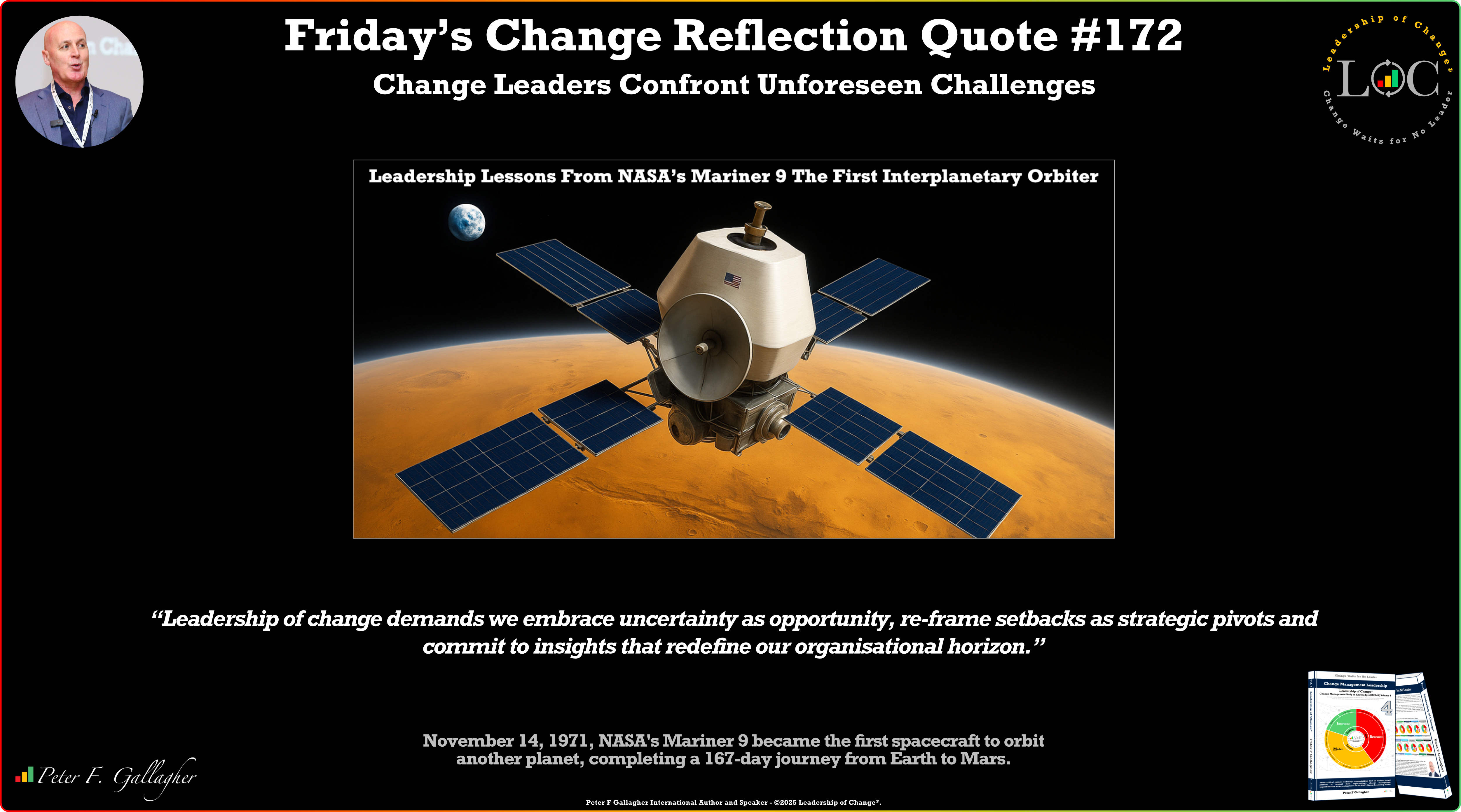Nov14

FCRQ172 Leadership Learning!
On November 14, 1971, NASA's Mariner 9 became the first spacecraft to orbit another planet, completing a 167-day journey from Earth to Mars. This unprecedented milestone marked humanity's transition from brief planetary flybys to sustained observation of another world. With this achievement, Mariner 9 assumed the distinction of entering into elliptical orbit around the red planet, enabling sustained observation of Mars rather than merely a fly-by encounter. In terms of historical facts: Mariner 9 was launched on 30 May 1971, from Cape Canaveral, travelled across interplanetary space to reach Mars in November, and entered orbit on 14 November, making it the first human-made object to establish orbit around another planet. During its mission it mapped up to 70–85% of Mars’ surface, returned over 7000 images and fundamentally changed our understanding of Martian geology, atmosphere and weather systems. The historical significance of this event lies in the boldness of setting a new frontier: shifting from fly-bys to orbiting other planets. Mariner 9’s success implied that systematic, long-term observation of an alien world was feasible, demonstrating new levels of complexity in mission design, risk management and global scientific collaboration. It came just months after the failure of its companion spacecraft Mariner 8 to reach orbit, highlighting resilience and adaptation within the programme. By orbiting Mars, Mariner 9 turned the page in planetary exploration: rather than snapshots, scientists now gained ongoing surveillance of another world’s surface, weather and moons. The mission uncovered vast volcanoes, canyons, and evidence of past water flows—features far more dynamic than had been anticipated—thus expanding the scientific paradigm of what Mars was and could have been. This transition from planning and execution to sustained monitoring mirrors what many organisations face when navigating major change. The combination of technological daring, adaptation to unexpected conditions (such as a planet-wide dust storm on arrival) and delivering a higher order of insight sets a powerful context for leadership of change. Many change efforts begin with ambitious intent, require adjusting to unanticipated realities, and must deliver meaningful new insight rather than incremental continuance. In short, the Mariner 9 mission encapsulates both the aspiration and the discipline of transformation. In light of these reflections it is clear that the launch of Mariner 9 was more than a technical feat: it was a paradigm shift in how humankind approached exploration and knowledge. Its relevance for leaders lies in the way it managed uncertainty, re-configured objectives, and delivered on a promise of new understanding. The event stands as a reminder that true progress demands stepping into the unknown, acknowledging turbulence, and still committing to a sustained mission. In an era of rapid change, that perspective remains vital.
Change Leadership Lessons: The Mariner 9 mission offers profound insights for contemporary change leadership. Change leaders must remain flexible when confronted with unforeseen challenges and adjust their strategies without losing focus on outcomes. When unforeseen disruptions occur, teams must take joint ownership of results to maintain mission continuity and organisational resilience. Effective change requires dedication to long-term progress, emphasising persistence and continuous learning rather than short-term wins. Successful transformation thrives on exceeding initial goals, creating outcomes that surpass planned targets through determination and creativity. True change leadership converts emerging information into new understanding, reshaping organisational direction and strengthening future strategic decisions. Change Leaders Confront Unforeseen Challenges.
“Leadership of change demands we embrace uncertainty as opportunity, re-frame setbacks as strategic pivots and commit to insights that redefine our organisational horizon.”
Application. Change Leadership Responsibility 1 - Articulate a Change Vision: Mariner 9's achievement reminds change leaders that articulating a compelling vision requires moving beyond familiar boundaries into uncharted territory. In organisational change, leaders must communicate a vision that balances bold ambition with pragmatic adaptability, much as the Mariner mission pivoted in response to the unexpected dust storm without abandoning its core objectives. Effective leaders articulate a change vision that encompasses both immediate challenges and sustained long-term outcomes, acknowledging uncertainty whilst maintaining clear direction. They demonstrate that transformation is not merely about reaching a destination but establishing new capabilities for continuous observation, learning and adjustment. By presenting a coherent vision that anticipates turbulence yet commits to sustained progress, change leaders transform organisational challenges into platforms for discovery and competitive advantage.
Final Thoughts: Today's leaders face unprecedented complexity as AI-driven transformation reshapes organisational landscapes at speeds comparable to the technological leaps of the space age. Just as Mariner 9 navigated through unexpected dust storms to deliver groundbreaking insights, change leaders must harness AI and emerging technologies to see through turbulence and sustain strategic vision. Effective leadership now requires the courage to commit to long-term transformation whilst adapting to conditions that earlier generations could never have imagined.
Further Reading: Change Management Leadership - Leadership of Change® Volume 4.
Peter F. Gallagher consults, speaks, and writes on Leadership of Change®. He works exclusively with boards, CEOs, and senior leadership teams to prepare and align them to effectively and proactively lead their organisations through change and transformation.
For insights on navigating organisational change, feel free to reach out at Peter.gallagher@a2B.consulting.
#LeadershipofChange #Leadership #ChangeLeadership #Thinkers360 #GlobalGurus #ChangeManagement #Mariner9 #Mars #Interplanetary #Spacecraft
For further reading please visit our websites: https://www.a2b.consulting https://www.peterfgallagher.com Amazon.com: Peter F Gallagher: Books, Biography, Blog, Audiobooks, Kindle
Leadership of Change® Body of Knowledge Volumes: Change Management Body of Knowledge (CMBoK) Books: Volumes 1, 2, 3, 4, 5, 6, 7, 8, 9, 10, A, B, C, D & E available on both Amazon and Google Play:
~ Leadership of Change® Volume 1 - Change Management Fables
~ Leadership of Change® Volume 2 - Change Management Pocket Guide
~ Leadership of Change® Volume 3 - Change Management Handbook
~ Leadership of Change® Volume 4 - Change Management Leadership
~ Leadership of Change® Volume 5 - Change Management Adoption
~ Leadership of Change® Volume 6 - Change Management Behaviour
~ Leadership of Change® Volume 7 - Change Management Sponsorship
~ Leadership of Change® Volume 8 - Change Management Charade
~ Leadership of Change® Volume 9 - Change Management Insanity
~ Leadership of Change® Volume 10 - Change Management Dilenttante
~ Leadership of Change® Volume A - Change Management Gamification - Leadership
~ Leadership of Change® Volume B - Change Management Gamification - Adoption
Keywords: Business Strategy, Change Management, Leadership
 When One Scanner Fails: Why Resilience Starts at the Smallest Link
When One Scanner Fails: Why Resilience Starts at the Smallest Link Friday’s Change Reflection Quote - Leadership of Change - Change Leaders Confront Unforeseen Challenges
Friday’s Change Reflection Quote - Leadership of Change - Change Leaders Confront Unforeseen Challenges The Corix Partners Friday Reading List - November 14, 2025
The Corix Partners Friday Reading List - November 14, 2025 The best is in the middle: why the C-suite must be the top bun
The best is in the middle: why the C-suite must be the top bun The Philosophical Schism in AI: Language, Causality, and the Divide Between LLMs and World Models
The Philosophical Schism in AI: Language, Causality, and the Divide Between LLMs and World Models